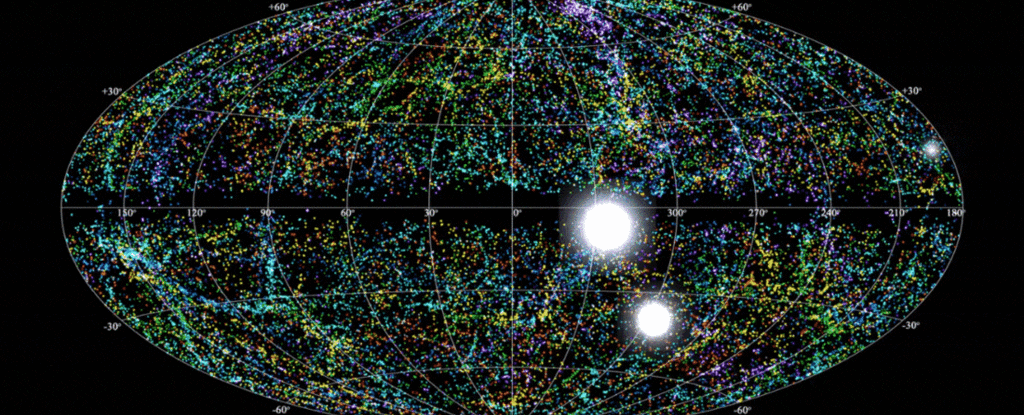One of the biggest mysteries out there in the Universe is inching closer to answers. An astonishing eight new repeating radio signals known as fast radio bursts (FRBs) have been detected flaring from deep space.
At the start of 2019, just one of these mysterious signals, FRB 121102, was known to flash repeatedly. In January, scientists reported a second repeating one (FRB 180814).
This new paper – available on preprint server arXiv, and submitted to The Astrophysical Journal Letters – describes eight new repeating signals detected by the Canadian Hydrogen Intensity Mapping Experiment (CHIME) radio telescope.
This brings the known total of repeating FRBs to 10. It means we’re starting to build a statistical database of repeaters, which could help astronomers to figure out what these signals actually are.
Fast radio bursts are certainly perplexing. They are detected as spikes in radio data, lasting just a few milliseconds. But, in that time, they can discharge more energy than 500 million Suns.
Most FRBs are only detected once and can’t be predicted, so tracing them back to their source is really tricky (although, as demonstrated earlier this year for the first time, not impossible).
That’s why repeaters are so important. And the news that they are not as rare as we thought means it might be possible to trace more back to their source galaxies, and determine what kinds of environments they come from.
We can also start looking for similarities and differences between repeating FRBs.
“There is definitely a difference between the sources, with some being more prolific than others,” physicist Ziggy Pleunis of McGill University told ScienceAlert.
“We already knew from FRB 121102 that the bursts can be very clustered: sometimes the source doesn’t burst for hours and hours and then suddenly you get multiple bursts in a short amount of time. We have observed the same thing for FRB 180916.J0158+65, for which we report ten bursts in this paper.”
On the other side of the scale, six of the FRBs reported in the paper only repeated once, and the longest pause between signals was over 20 hours. The eighth one (FRB 181119) repeated twice after the initial detection, pinging a total of three times.
We don’t yet know what this means, but it could indicate – as hypothesised in a paper last month by Harvard-Smithsonian astrophysicist Vikram Ravi – that all FRBs are actually repeaters, but some are a lot more active than others.
“Just as some volcanoes are more active than others, and you can think a volcano is dormant because it has not erupted in a long time,” Pleunis noted.
But there are similarities between FRBs, too. The individual bursts from repeaters seem to last a little bit longer than the bursts from one-off FRBs. That’s pretty interesting.
There’s also the frequency drift. The first two repeaters – FRB 121102 and FRB 180814 – showed a downward drift in frequency, with each burst getting successively lower. Think of a sad trombone sound effect.
Most of the eight new repeaters, also demonstrated this downward frequency drift. This could be a clue as to what’s producing the signals.
“I just think it is so amazing that nature produces something like that,” Pleunis said. “Also, I think that there is some very important information in that structure that we just have to figure out how to encode and it has been a lot of fun to try to figure out what exactly that is”
CHIME is optimised for monitoring a very broad swathe of the sky, across a lower range of frequencies than radio telescopes like ASKAP or the Parkes Observatory in Australia, which have also detected FRBs.
So far, CHIME’s approach is proving remarkably effective at detection. In addition to these repeaters, and the repeater announced in January, CHIME has detected a number of one-off bursts, too. It’s not optimised for tracing those detections to a source, though.
That’s where the broader scientific community comes in. Just today, a different team of researchers, including Ravi, announced they had made headway localising the eight new repeatersFRB, researchers, telescopes, galaxies, to known galaxies, just based on the direction the signals came from.
We can even roughly tell how far away the bursts may have originated based on how dispersed the signal is – the higher these measures, the farther the distance.
In fact, this is where it gets intriguing, because one of the signals, FRB 180916, has the lowest dispersion seen yet, indicating that it could be nearby.
“Even with the biggest telescopes, if it’s closer to you, you always get a better view than if it’s something farther away,” astronomer Keith Bannister from Australia’s national science agency CSIRO, who was not involved in the research, told ScienceAlert.
“So that particular low dispersion measure was super exciting, because there’s a good chance that that will be nearby. And that means it will be easier to look at, once we really know exactly where it is in the sky.”
The polarization of the signals (how twisted the signal is) is informative, too. If the signal is really twisted up, it means it came from an extreme magnetic environment, such as can be found around a black hole or neutron star. This is what the signal from FRB 121102 was like.
But the team was able to measure the polarisation of one of the new signals, FRB 180916, and it was really low. This tells us that not all repeating FRBs come from extreme environments.
We don’t know what this means yet. We don’t know if there are several different classes of objects or events producing these signals. We don’t know if they all repeat, or why they repeat. But these results are bringing us tantalisingly close to finally having some answers.
“I think (and I hope!) the paper will prompt other astronomers to point their telescopes to these newly discovered sources,” Pleunis said.
“Then, there is a lot of information here for model builders to work with. I think it will help them figure out what produces repeating FRBs.
“Also, I think our findings will influence the search strategy of other teams that try to discover repeating FRBs.”
Keep your eyes and hears open to the sky and space, you might make a new friend. Love and Regards,
Thank You,
Nancy Thames
Nancy and son UFO Gazing




